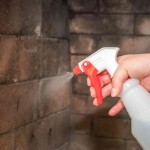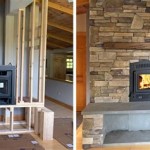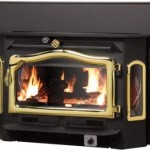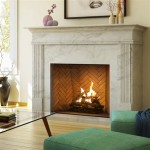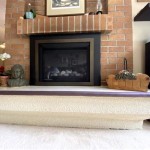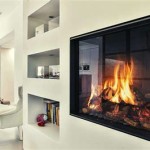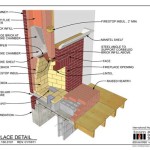Parts of a Fireplace: A Comprehensive Guide
A fireplace, a timeless architectural feature, serves as both a source of warmth and a focal point in residential and commercial spaces. While the basic function remains consistent – providing heat through controlled combustion – the design and components of a fireplace have evolved over centuries. Understanding the specific terminology and function of each part is crucial for proper operation, maintenance, and potential restoration.
This article provides a detailed overview of the key components of a fireplace, focusing on both traditional masonry fireplaces and modern prefabricated units. The descriptions will cover the structure from the firebox to the chimney, including essential safety features and aesthetic elements.
### The Firebox: Heart of the FireplaceThe firebox is the central compartment of the fireplace where combustion occurs. It is designed to withstand the high temperatures generated by burning fuel, typically wood or gas. The construction material is invariably heat-resistant, with firebrick being the most common choice in masonry fireplaces. Firebrick is a type of refractory brick specifically designed to endure extreme heat without cracking or deteriorating. Its dense composition and low thermal expansion minimize heat loss and prevent the fire from damaging the surrounding structure.
In prefabricated fireplaces, the firebox is often constructed from heavy-gauge steel or cast iron. These materials offer excellent heat resistance and durability, and may be coated with a porcelain enamel or other heat-resistant finish for added protection and aesthetic appeal. Prefabricated fireboxes are typically enclosed within a metal housing.
Within the firebox, several elements contribute to efficient and safe combustion. The grate, traditionally made of cast iron or steel, elevates the fuel above the floor of the firebox, allowing air to circulate underneath and promote more complete combustion. The firebox is also often surrounded by refractory panels, which reflect heat back into the room, increasing the fireplace's efficiency. These panels are often decorative, adding to the overall aesthetic of the fireplace.
The overall dimensions of the firebox are critical for optimal performance. A properly sized firebox will facilitate good draft, ensuring that smoke and gases are efficiently drawn up the chimney. An undersized firebox can lead to smoke spillage into the room, while an oversized firebox may not generate enough heat for effective warmth.
### The Smoke Chamber and Damper: Controlling the FlowAbove the firebox is the smoke chamber, a transitional area that converges the smoke and hot gases rising from the fire into the relatively narrow flue of the chimney. The shape of the smoke chamber is crucial for efficient draft. Ideally, it should be smooth and tapered to minimize turbulence and resistance to airflow. In masonry fireplaces, the smoke chamber is typically constructed of brick or stone, parged with a smooth layer of mortar to seal any gaps and create a uniform surface.
The damper is located at the base of the smoke chamber, acting as a valve to control airflow through the chimney. When open, the damper allows smoke and gases to escape during a fire. When closed, it prevents drafts from entering the room when the fireplace is not in use. Dampers are typically made of cast iron or steel, and can be operated manually or automatically.
A properly functioning damper is critical for both energy efficiency and safety. A closed damper prevents heat loss from the room up the chimney, saving energy and reducing heating costs. It also prevents cold drafts from entering the room during colder months. Furthermore, a closed damper can prevent animals and debris from entering the chimney and potentially causing a blockage. Regular inspection and maintenance of the damper are essential to ensure its proper operation.
Damper designs vary. Throat dampers are located directly above the firebox and are the most common type. Top-sealing dampers, installed at the top of the chimney, provide a tighter seal and offer better energy efficiency. These dampers are often operated by a cable that runs down the chimney to the firebox.
### The Chimney: Ventilation and SafetyThe chimney is the vertical structure that carries smoke and gases away from the fireplace to the outside atmosphere. It is arguably the most important safety component of a fireplace system. The chimney must be properly constructed and maintained to prevent the buildup of creosote, a highly flammable byproduct of wood combustion that can lead to chimney fires.
Chimneys are typically constructed of brick, stone, or metal. Masonry chimneys are built with an inner lining called a flue, which is made of fireclay tiles or a similar heat-resistant material. The flue protects the surrounding masonry from the corrosive effects of smoke and gases, and provides a smooth surface for efficient drafting. Metal chimneys, often used with prefabricated fireplaces, are typically double-walled and insulated to prevent heat transfer to combustible materials.
The height of the chimney is crucial for proper draft. A chimney that is too short may not generate enough draft to effectively remove smoke and gases, leading to smoke spillage into the room. Building codes typically specify minimum chimney heights based on the roof's pitch and proximity to other structures. Regular chimney inspections and cleaning are essential to ensure safe and efficient operation. A qualified chimney sweep can remove creosote buildup and identify any potential problems, such as cracks or blockages.
Chimney caps are installed at the top of the chimney to prevent rain, snow, and debris from entering. They also help to prevent animals from nesting in the chimney. Chimney caps are available in a variety of styles and materials, including stainless steel and copper.
The space surrounding the chimney as it passes through walls and the roof must adhere to strict clearance requirements from combustible materials. This is to prevent heat transfer from the chimney igniting the surrounding structure. These clearances are typically specified in building codes and must be carefully followed during construction.
### Additional Components and ConsiderationsBeyond the core components of the firebox, smoke chamber, and chimney, several other elements contribute to the overall functionality and aesthetics of a fireplace. The hearth is the non-combustible area in front of the firebox, designed to protect the floor from sparks and embers. Hearths are typically made of brick, stone, tile, or other non-combustible materials. The size of the hearth is also regulated by building codes to ensure adequate protection.
The fireplace surround is the decorative facing that surrounds the firebox opening. Surrounds can be made of a variety of materials, including wood, stone, tile, or metal. The surround adds to the aesthetic appeal of the fireplace and can be customized to complement the room's decor.
Mantels are decorative shelves or structures that are installed above the firebox opening. Mantels provide a focal point for the fireplace and can be used to display artwork, photographs, or other decorative items. Mantels must be installed at a safe distance above the firebox to prevent them from catching fire.
Gas fireplaces require additional components such as gas lines, valves, and burners. These components must be installed and maintained by qualified professionals to ensure safe and reliable operation. Gas fireplaces may also be equipped with remote controls, thermostats, and other features for added convenience.
Proper ventilation is crucial for any fireplace system. Inadequate ventilation can lead to smoke spillage into the room and can also contribute to indoor air pollution. Homes with fireplaces should be equipped with carbon monoxide detectors to warn of potentially dangerous levels of this odorless and invisible gas. It's crucial to ensure the home has adequate fresh air intake to support combustion and prevent negative pressure issues that can hinder proper fireplace drafting.
Understanding the function of each part of a fireplace is essential for safe and efficient operation. Regular inspection and maintenance are crucial for preventing problems and ensuring the longevity of the fireplace system. Consulting with qualified professionals for installation, repair, and maintenance is highly recommended.

What Are The Components Of A Fireplace Five Ways Fires

Understanding The Anatomy Of A Fireplace Madewell Masonry

Chimney Parts And How They Work 2024 All Pro Service

Getting To Know Your Fireplace Waterloo Kitchener Fireplaces Custom Cabinetry

Result For Fireplace Parts Shiplap Feature Wall Mantel Surrounds Remodel

Get Fired Up Transform Your Fireplace Homesquare

House Heating Wood Firing Fireplace Visual Dictionary

Fireplace Anatomy

Informational Blog Fireplace Hearth Chimney Design

Fireplace Terms

